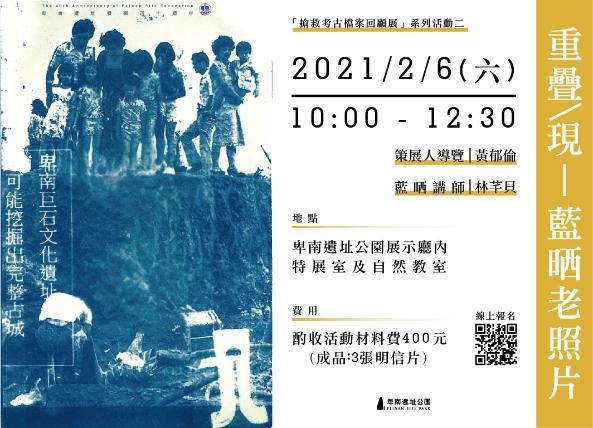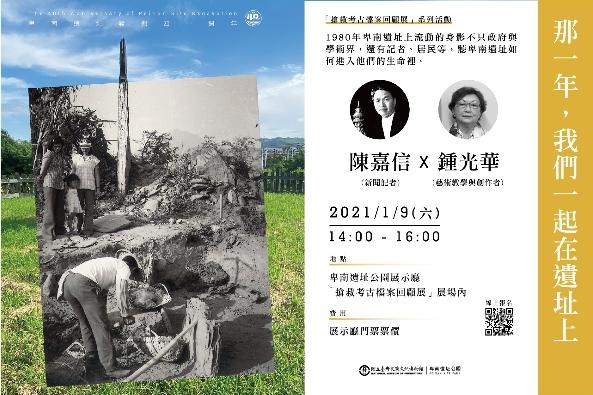-
 主辦單位
:
史前館|卑南遺址公園
主辦單位
:
史前館|卑南遺址公園
-
 票價說明
:
憑展示廳門票入場
票價說明
:
憑展示廳門票入場
-
 開放時間
:
週二至週日 09:00-17:00
開放時間
:
週二至週日 09:00-17:00
*展覽延至2021年4月18日(日)
「搶救考古」(salvage archaeology)是指工程開發因發現遺址而停工,先進行考古發掘以獲取遺址文化內涵,減少因工程破壞而流失的資料。臺灣地狹人稠、開發密集,因而學者長期疲於奔命到處進行搶救考古,其中卑南遺址可謂臺灣搶救考古的開端。1980年7月1日南迴鐵路盛大開工,臺東車站興建工程卻在前一天的整地與取土作業,意外鏟出石板、骨骸與遺物,因而啟動搶救考古。當年的發掘規模在臺灣考古史上至今仍堪稱空前絕後,除了造就一座國家博物館,更催生臺灣《文化資產保存法》。
本展覽鎖定卑南遺址搶救考古初期最兵荒馬亂的1980至1982年。由於臺東在地文化人士的共同努力,加上媒體效益與學術關注,卑南遺址得以在工程執行率、非法盜掘、預算延宕等多重壓力下,啟動臺灣首次的搶救考古。事實上,在卑南遺址事件之前,臺東因特殊的地緣條件,在地早已萌芽對考古與文資保存的公民意識。本展覽透過文獻檔案資料、新聞攝影報導,片段還原當時遺址上流動的身影與捲動的利害關係,回顧卑南遺址帶給臺灣公民社會的一堂課。
Salvage archaeology refers to archaeological survey and excavation carried out in advance of new construction or other land development in order to preserve those data and materials from a site in danger of imminent destruction. Taiwan is a small island with dense population and development, and the local scholars have been exhausted from rescuing the archaeological sites. On June 30th 1980, the day before the commencement of South-link Line railway construction, a large number of slates, remains and artifacts were accidentally unearthed during the land clearance for the new station. The Peinan Site salvage excavation was therefore initiated and considered the first case and by far the largest in scale in the history of Taiwan's archaeology. It not only brought about the establishment of a national museum, but also paved the way for the Cultural Heritage Preservation Act in Taiwan.
This exhibition focuses on the beginning and most hustling phase of the salvage excavation of Peinan Site from 1980 to 1982. The so-called "salvage archaeology" was initiated for the first time in Taiwan thanks to the joint efforts from local cultural fields, academics, and the media, under the circumstances of slow engineering execution, looting and illicit trade, and budget delay. As a matter of fact, the civic consciousness of preserving archaeological and cultural heritage had been developed in Taitung before the Peinan Site incident due to its geographical significance. This exhibition retrospects the intricate relationships among the involved figures through the archives, press photos and articles, which represents an important lesson the Peinan Site had offered to Taiwan's civil society.

媒體發掘 Media Coverage
1980年6月30日,全臺沉浸在地方建設起飛的欣欣向榮之中,臺東車站興建工程為了隔日預計舉行的南迴鐵路開工典禮,怪手正一起一落進行整地、挖取土方。鐵路局不知這片地在前一年已核定為三級古蹟,未料怪手接連耙起破碎石板、殘肢骸骨,及大量的玉器與陶器。隔日南迴鐵路照常開工,盛大慶祝,直到兩週後臺東在地記者率先報導,才引起新聞媒體爭相採訪。在本土意識興起的80年代初,卑南遺址上的最新動態透過報章雜誌定期傳送到大眾面前,得以形成社會輿論及各界關注;卑南遺址能成為臺灣搶救考古的開端,年輕地方記者功不可沒。
On June 30th 1980, the day before the commencement ceremony of South-link Line for the new Taitung Station, the whole society was overwhelmed by the advancement of Taiwan's infrastructure construction. TRA (Taiwan Railway Administration) did not notice that the site was classified as a third-rank national historic site one year before, and continued the land clearance until a large number of slate objects, bones, jade and pottery being dug out and devastatingly ruined. The ceremony remained the next day and the incident was then brought to the public's attention by the local journalists two weeks later, which aroused more media coverage. In the early 80s with the awakening of localism, the latest updates of Peinan Site were constantly brought to the public via newspapers and magazines, forming the public opinions and drawing attention from the whole society. It has become the pioneer of salvage archaeology in Taiwan, and the credit goes to the local young journalists.

聯合報 1980年6月30日 頭版新聞
怪手與守護者 Excavators and Gatekeepers
本區展出的兩份官方簡報,見證臺東縣政府與臺大人類學系在關鍵時刻,為保留卑南遺址所付出的努力與策略。在更早之前,兩單位即因臺東縣境內豐富的考古遺址而往來密切,當卑南遺址事件爆發,十多年來在地所醞釀對考古的關懷,在公務人員與民間人士當中發酵,他們成為卑南遺址的重要守護者,與學術界互相照應。學生們臨危受命組成考古隊,和在地雇工與義工攜手執行搶救發掘。媒體效益引來的參觀民眾絡繹不絕,然而也引來意圖牟利的盜掘者,從文獻檔案中可窺見當時交易買賣的盛況。鐵路局蓄勢待發的施工怪手、投機者伺機而動的盜掘怪手、考古隊不得已雇用的發掘怪手,成為1980至1982年卑南遺址上的一景。
Two official documents presented in this area accounted for the efforts and strategies made by the Taitung County Government and the Anthropology Department of NTU (National Taiwan University) to preserve the Peinan Site. The collaboration had been made long before the incident due to the rich archaeological sites discovered in Taitung. When the incident was revealed, the decade-long concerns and awareness were further developed among the local governments and residents, who became the important gatekeepers of Peinan Site and cooperated counterparts for the academics. Students were also assigned to the archaeological excavation teams in need. They worked hand in hand with locally hired workers and volunteers to operate the salvage excavation. The impact of the press not only kept attracting visitors, but also drew profit-oriented traders, and according to the documents, illicit trading was quite thriving. The TRA excavators, illegal looters, and the NTU archaeological team formed a unique spectacle on the Peinan Site during the years from 1980 to 1982.
-陳嘉信攝.jpg?v=93ef9e44-442b-4624-b2fa-72a88367cc74)
1980年7月26日省政府民政廳協調行政與學術單位至卑南遺址現勘,
照片中清楚可見禁止盜掘告示牌及月形石柱。攝影:陳嘉信

延長搶救考古發掘期限協議書,1980年10月15日。
附件 - 東縣鐵路拓寬卑南新站址與卑南文化保護區示意圖
一九八〇之外 Beyond Year 1980
1980年或許不能算是卑南遺址首次的搶救考古,史前館籌建也並非只是因為卑南遺址的緣故。1945年初,擔心戰事對卑南遺址造成無法挽回的破壞,金關丈夫和國分直一在美軍空襲下擅自進行發掘作業;本區展出的錄像作品是日籍藝術家mamoru嘗試理解兩位考古學者所處的時空,並連結現地調查與訪談後的創作。1967年鯉魚山遺址因興建龍鳳寺而暴露地表、1968年八仙洞遺址考古發掘以及隔年由考古學者主持的科際整合「東研計畫」等緣故,臺東縣政府早已多次向中央提出興建古物陳列館的請求;建館提案因卑南遺址而獲核定,但適逢80年代盛行遊樂區開發,當年館舍預定地曾短暫納入知本的東部綜合遊樂區空間規劃中。
卑南遺址事件約十年後,爆發北部十三行遺址存續與民生建設的衝突,約三十年後爆發東部漢本遺址搶救考古與交通建設的爭議;十三行遺址雖遭破壞殆盡但在各界努力下設立了臺灣第二座考古博物館,漢本遺址則在民意代表與公民團體的積極介入下迅速登錄為國定考古遺址。卑南遺址事件持續為往後其他的考古遺址帶來影響,不只是開端,更成為搶救考古的經典案例。
Neither 1980 was the first time when relics were salvaged on the Peinan Site, nor the National Museum of Prehistory was established simply due to such an incident. In the early 1945, with the fear of the irretrievable damage to the site, KANASEKI Takeo and KOBUKU Naoichi conducted private archaeological excavations during the time of the U.S. air raid. The video in the following area demonstrates a Japanese sound artist, mamoru's attempt to represent the contextual background in 1945, with connection to his in situ investigation. In 1967, Liyu Hill Site was exposed owing to the building work of Longfeng Temple; in 1968, archaeologists conducted excavation on Baxiandong Site and convened a cross-disciplinary research project in Eastern Taiwan one year later. The Taitung County Government had demanded for an archaeology museum for many years, and it was not approved until 1980 due to the discovery of the Peinan Site. The museum was once considered to be located in the Zhiben amusement park in the 80s, a land development project which was never fulfilled.
About a decade after the Peinan Site incident, conflicts between the preservation of Shisanhang Site and local development broke out; 30 years later, the controversy of Hanben Site over the salvage archaeology and transport infrastructure construction continued the debate. Although the Shisanhang Site was eventually destroyed, the second archaeology museum in Taiwan was established on that site thanks to the efforts across all sectors. Nevertheless, the Hanben Site was immediately enlisted as one of the national archaeological sites through the intervention of elected representatives and citizen groups. The Peinan Site incident in the 80s has constantly influenced many other sites on this island. It was not only a starting point, but also the most classic case for salvage archaeology in Taiwan.
We melt them and pour it on the ground (2020, artist: mamoru)
策展 : 黃郁倫|展覽設計 : Peter Chen|視覺設計 : 高雪娟|黑白攝影 : 陳嘉信|執行製作 : 品文設計
協力 : 新北市立十三行博物館、國立臺灣大學圖書館特藏組、公共電視文化事業基金會、中華電視股份有限公司、聯合線上股份有限公司、mamoru、陳嘉信、高筱慧、韓旭東、黃國恩、康芸甯、李麗雲、林佳靜、林建成、林慎孜、林頌恩、屈慧麗、王勁之、王強、王嵩山、吳漢成、吳小純、夏麗芳、楊淑玲、姚書宇、葉長庚、葉美珍、曾世聰、張靜婷、鍾光華 (依姓名羅馬拼音排列)
翻譯 : 李莉莉、Peter Chen


